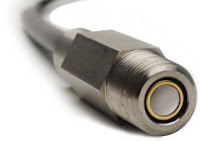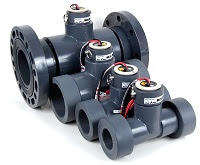 |
| Internet of Things (IoT) Sensor Classification from Black Box Paradox. |
- Proximity Sensor - A proximity sensor is a sensor able to detect the presence of nearby objects without any physical contact.
- Position Sensor - A position sensor is any device that permits position measurement.
- Presence (or Occupancy) Sensor - An occupancy sensor is a motion detecting devices used to detect the presence of a person or object.
- Motion Sensor - A motion detector is a device that detects moving objects. Such a device is often integrated as a component of a system that automatically performs a task or alerts a user of motion in an area.
- Velocity Sensor - A velocity receiver (velocity sensor) is a sensor that responds to velocity rather than absolute position.
- Displacement Sensor - A displacement sensor (displacement gauge) is used to measure travel range between where an object is and a reference position. Displacement sensors can be used for dimension measurement to determine an object's height, thickness, and width in addition to travel range.
The temperature sensor detects the current temperature or changes in temperature. There is a large number of temperature sensors available and a comprehensive list is available on Wikipedia.
- Humidity Sensor - A humidity sensor (or hygrometer) senses, measures and reports the relative humidity in the air. It therefore measures both moisture and air temperature.
- Moisture sensor - A moisture sensor is an instrument used for measuring the water vapor in the atmosphere. Sometime considered same device as humidity sensor.
- Acoustic Sensor - Surface acoustic wave sensors are a class of microelectromechanical systems (MEMS) which rely on the modulation of surface acoustic waves to sense a physical phenomenon.
- Sound sensor - Sound Sensor can detect the sound intensity of the environment. The Sound Detector is a small board that combines a microphone and some processing circuitry. It provides not only an audio output, but also a binary indication of the presence of sound, and an analog representation of it's amplitude.
- Vibration sensor - a vibration sensor can detect vibrations. A transducer, such as that incorporating a laser or a piezoelectric crystal, which converts vibrations into an electrical equivalent such as a voltage. Also called vibration transducer, or vibration pickup.
- Chemical Sensor - A chemical sensor is a self-contained analytical device that can provide information about the chemical composition of its environment, that is, a liquid or a gas phase.
- Gas sensor - A gas detector is a device that detects the presence of gases in an area, often as part of a safety system. This type of equipment is used to detect a gas leak or other emissions and can interface with a control system so a process can be automatically shut down.
- Flow
Flow Sensors monitor liquid flow rates and accumulated flow volume. Flow measurement is the quantification of bulk fluid movement and can be measured in a variety of ways.
- Force / Load / Torque / Strain / Pressure
- Force Sensor - A Force Sensor is defined as a transducer that converts an input mechanical force into an electrical output signal. Force Sensors are also commonly known as Force Transducers.
- Load Sensor - A Load Sensor is defined as a transducer that converts an input mechanical force into an electrical output signal. Load Sensors are also commonly known as Load Transducers or Load Cells.
- Torque Sensor - A torque sensor, torque transducer or torque meter is a device for measuring and recording the torque on a rotating system, such as an engine, crankshaft, gearbox, transmission, rotor, a bicycle crank or cap torque tester. Static torque is relatively easy to measure.
- Strain Sensor - A Strain gage (sometimes referred to as a Strain Gauge) is a sensor whose resistance varies with applied force; It converts force, pressure, tension, weight, etc., into a change in electrical resistance which can then be measured.
- Pressure - A pressure sensor is a device for pressure measurement of gases or liquids. Pressure is an expression of the force required to stop a fluid from expanding, and is usually stated in terms of force per unit area. A pressure sensor usually acts as a transducer; it generates a signal as a function of the pressure imposed.
- Leaks / Levels
- Leak Sensor - leak detection is used to determine if and in some cases where a leak has occurred in systems which contain liquids and gases.
- Level Sensor - Level sensors detect the level of liquids and other fluids and fluidized solids, including slurries, granular materials, and powders that exhibit an upper free surface.
- Electric / Magnetic
- Electric Sensor - A current sensor is a device that detects electric current in a wire, and generates a signal proportional to that current. The generated signal could be analog voltage or current or even a digital output. The generated signal can be then used to display the measured current in an ammeter, or can be stored for further analysis in a data acquisition system, or can be used for the purpose of control.
- Magnetic Sensor - A MEMS magnetic field sensor is a small-scale microelectromechanical systems (MEMS) device for detecting and measuring magnetic fields (Magnetometer).
- Acceleration / Tilt
- Acceleration Sensor - An accelerometer is a device that measures proper acceleration. Proper acceleration, being the acceleration (or rate of change of velocity) of a body in its own instantaneous rest frame, is not the same as coordinate acceleration, being the acceleration in a fixed coordinate system.
- Tilt Sensor - A clinometer or inclinometer is an instrument for measuring angles of slope (or tilt), elevation or depression of an object with respect to gravity. It is also known as a tilt indicator, tilt sensor, tilt meter, slope alert, slope gauge, gradient meter, gradiometer, level gauge, level meter, declinometer, and pitch & roll indicator.
- Machine Vision / Optical / Ambient Light
- Machine Vision Sensor - As a simple concept, machine vision is the use of devices for optical non-contact sensing to automatically receive and interpret an image of a real scene in order to obtain information and/or control machines or processes. Machine vision (MV) is the technology and methods used to provide imaging-based automatic inspection and analysis for such applications as automatic inspection, process control, and robot guidance, usually in industry. Machine vision is a term encompassing a large number of technologies, software and hardware products, integrated systems, actions, methods and expertise. Machine vision as a systems engineering discipline can be considered distinct from computer vision, a form of computer science.
- Optical Sensor - Electro-optical sensors are electronic detectors that convert light, or a change in light, into an electronic signal.
- Ambient Light Sensor - A device that detects the amount of light in the vicinity. An ambient light sensor may be built into a smartphone or tablet to adjust the screen brightness based on the available light.
Security matters!
It is also very important to note that as sensors become increasingly available and controlled over the network, security should be of huge concern. Industrial controllers are becoming increasingly targeted for security vulnerabilities and if an oceans sensor is available from a remote location over a network it is potentially open to attack. Being aware of the data available from the sensor and any control features the sensor (activator, controller) may have.
It is also very important to note that as sensors become increasingly available and controlled over the network, security should be of huge concern. Industrial controllers are becoming increasingly targeted for security vulnerabilities and if an oceans sensor is available from a remote location over a network it is potentially open to attack. Being aware of the data available from the sensor and any control features the sensor (activator, controller) may have.
The other end
When considering the digitization of oceans reference architecture and what is considered an end-point we need to also look to the other end. And by the other end, I mean the data storage end. In this post we have discussed all the end points that emit the data, and at some point the data will need to be "at rest" stored in some storage device. The topic of data storage will be discussed in a later post.
When considering the digitization of oceans reference architecture and what is considered an end-point we need to also look to the other end. And by the other end, I mean the data storage end. In this post we have discussed all the end points that emit the data, and at some point the data will need to be "at rest" stored in some storage device. The topic of data storage will be discussed in a later post.
Some examples of end-points
Over the next few months I will be publishing a series of blog posts describing, in more detail, all the aspects for building a successful digitization of oceans reference architecture. Next up is; "communications" with focus on the data communications available to oceans technology. Please follow along and make comment. For a table of contents of these coming posts please review a companion post; Digitization of Oceans Reference Architecture TOC
- Nomad - The AXYS NOMAD is a unique aluminum environmental monitoring buoy designed for deployments in extreme conditions. The NOMAD (Navy Oceanographic Meteorological Automatic Device) is a modified version of the 6m hull originally designed in the 1940’s for the U.S. Navy’s offshore data collection program. It has been operating in Canada’s Weather Buoy network for over 25 years and commonly experiences winter storms and hurricanes with wave heights approaching 20m.
- Coast Guard Canada - it is very hard to imagine this autonomous vessel will not be loaded with sensors to collect data. Portsmouth, UK, based ASV Global has converted a 26ft hydrographic survey launch to enable it to operate autonomously using the ASView control system, while maintaining its ability to operate in a conventional manned mode. The launch, which is part of the Canadian Coast Guard’s fleet dedicated to the survey operations of the Canadian Hydrographic Service, will be used as a test platform for unmanned survey work.
- Personal Weather Stations - A personal weather station is a set of weather measuring instruments operated by a private individual, club, association, or even business (where obtaining and distributing weather data is not a part of the entity's business operation). Personal weather stations have become more advanced and can include many different sensors to measure weather conditions. These sensors can vary between models but most measure wind speed, wind direction, outdoor and indoor temperatures, outdoor and indoor humidity, barometric pressure, rainfall, and finally UV or solar radiation.
Over the next few months I will be publishing a series of blog posts describing, in more detail, all the aspects for building a successful digitization of oceans reference architecture. Next up is; "communications" with focus on the data communications available to oceans technology. Please follow along and make comment. For a table of contents of these coming posts please review a companion post; Digitization of Oceans Reference Architecture TOC














